sensor MERCEDES-BENZ SLC-Class 2017 R172 Owner's Manual
[x] Cancel search | Manufacturer: MERCEDES-BENZ, Model Year: 2017, Model line: SLC-Class, Model: MERCEDES-BENZ SLC-Class 2017 R172Pages: 294, PDF Size: 7.28 MB
Page 7 of 294
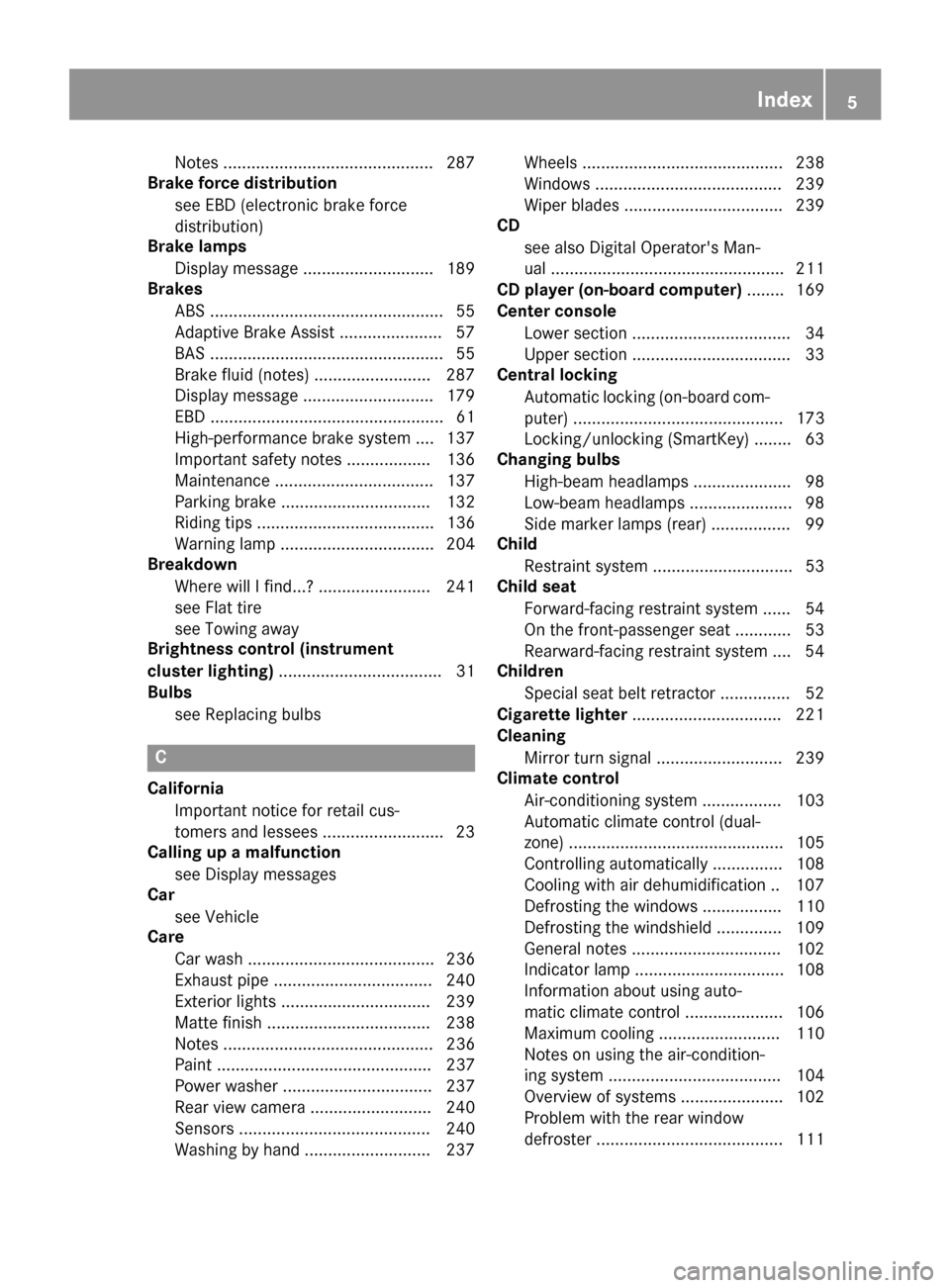
Notes .............................................287
Brake force distribution
see EBD (electronic brake force
distribution)
Brake lamps
Display message ............................ 189
Brakes
ABS ..................................................5 5
Adaptive Brake Assist ...................... 57
BAS .................................................. 55
Brake fluid (notes) ......................... 287
Display message ............................ 179
EBD .................................................. 61
High-performance brake system .... 137
Important safety notes. ................. 136
Maintenance .................................. 137
Parking brake ................................ 132
Riding tip s...................................... 136
Warning lamp ................................. 204
Breakdown
Where will Ifind...? ........................ 241
see Fla ttire
see Towing away
Brightness control( instrument
cluste rlighting) ................................... 31
Bulbs
see Replacing bulbs
C
CaliforniaImportant notice for retail cus-
tomers and lessees .......................... 23
Calling up amalfunction
see Displa ymessages
Car
see Vehicle
Care
Carw ash. ....................................... 236
Exhaus tpipe. ................................. 240
Exterior lights ................................ 239
Matte finish ................................... 238
Note s............................................. 236
Paint .............................................. 237
Power washer. ............................... 237
Rear vie wcamera .......................... 240
Sensors ......................................... 240
Washing by hand ........................... 237 Wheels.
.......................................... 238
Window s........................................ 239
Wipe rblade s.................................. 239
CD
see also Digital Operator's Man-
ual.................................................. 211
CD player (on-board computer) ........ 169
Centerc onsole
Lower section .................................. 34
Upper section .................................. 33
Central locking
Automati cloc king (on-board com-
puter) ............................................. 173
Locking/unlocking (SmartKey )........ 63
Changin gbulbs
High-beam headlamp s..................... 98
Low-bea mheadlamp s...................... 98
Sid em arker lamps (rear) ................. 99
Child
Restraint system .............................. 53
Child seat
Forward-facing restraint system ...... 54
On the front-passenger sea t............ 53
Rearward-facing restraint system .... 54
Children
Specia lsea tb eltr etractor ............... 52
Cigarette lighter ................................ 221
Cleaning
Mirror turn signal ........................... 239
Climate control
Air-conditioning system ................. 103
Automati cclimate control (dual-
zone) .............................................. 105
Controlling automaticall y............... 108
Cooling with ai rdehumidifica tion .. 107
Defrosting the window s................. 110
Defrosting the windshield .............. 109
Genera lnotes ................................ 102
Indicato rlam p................................ 108
Information aboutu sing auto-
mati cclimate control ..................... 106
Ma
ximu mcooling .......................... 110
Note sonu sing the air-condition-
ing system ..................................... 104
Overview of systems ...................... 102
Problem with the rea rwindow
defroster ........................................ 111
Index5
Page 15 of 294
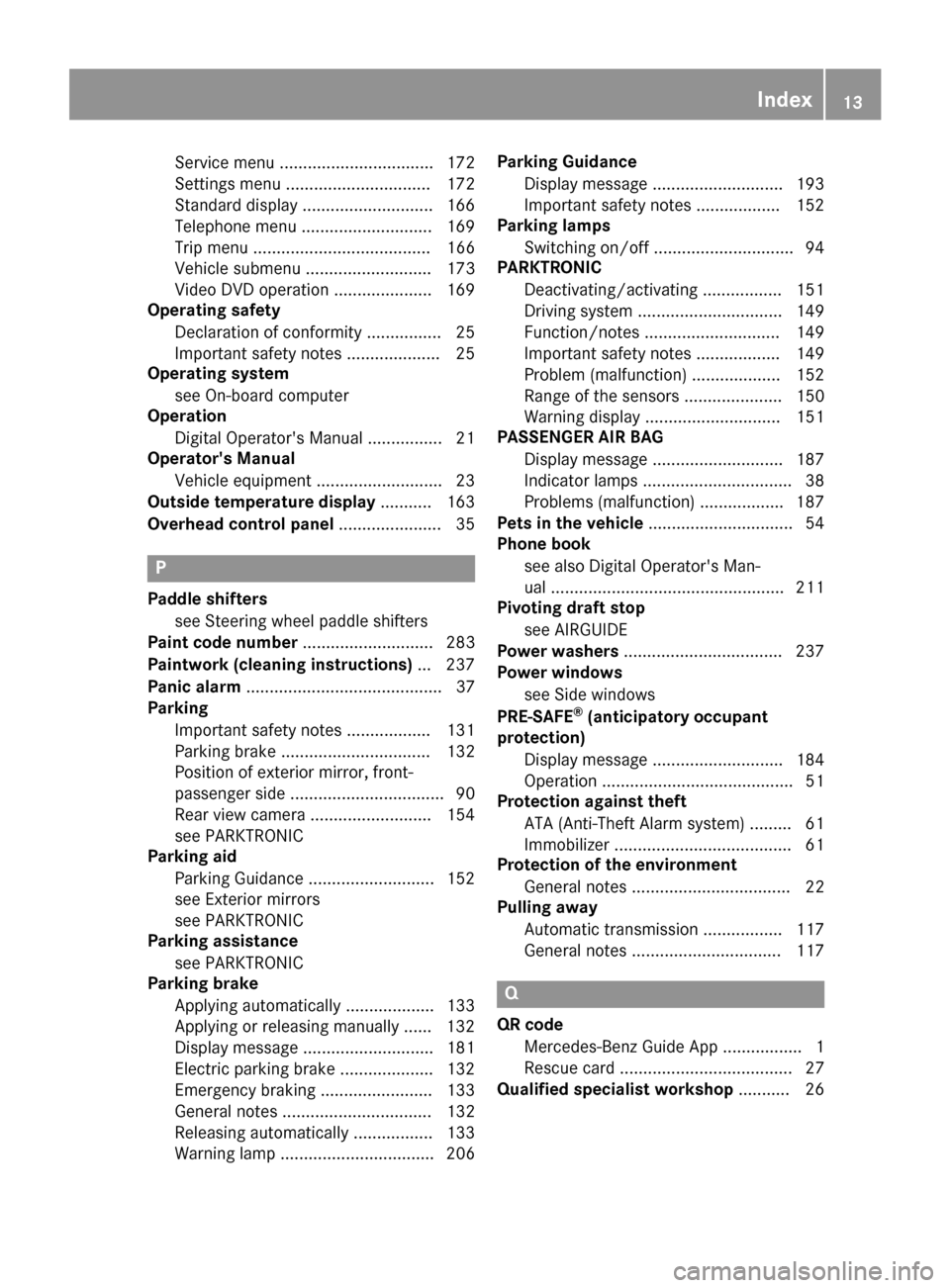
Service menu ................................. 172
Settingsmenu ............................... 172
Standard display ............................ 166
Telephone menu ............................ 169
Tri pm enu ...................................... 166
Vehicl esubmenu ........................... 173
Video DVD operation ..................... 169
Operatin gsafety
Declaration of conformity ................ 25
Important safety notes .................... 25
Operatin gsystem
see On-board computer
Operation
Digital Operator's Manua l................ 21
Operator's Manual
Vehicl eequipment ........................... 23
Outside temperature display ........... 163
Overhead controlp anel...................... 35
P
Paddles hifters
see Steering wheelp addleshifters
Paint code number ............................ 283
Paintwork (cleaning instructions) ... 237
Panic alarm .......................................... 37
Parking
Important safety notes .................. 131
Parking brake ................................ 132
Position of exterio rmirror, front-
passenger sid e................................. 90
Rear vie wcamera .......................... 154
see PARKTRONIC
Parking aid
Parking Guidance ........................... 152
see Exterior mirrors
see PARKTRONIC
Parking assistance
see PARKTRONIC
Parking brake
Applying automaticall y................... 133
Applying or releasing manually ...... 132
Displa ymessage ............................ 181
Electric parking brake .................... 132
Emergency braking ........................ 133
Genera lnotes ................................ 132
Releasing automaticall y................. 133
Warning lamp ................................. 206 Parking Guidance
Displa ymessage ............................ 193
Important safety notes .................. 152
Parking lamps
Switching on/of f.............................. 94
PARKTRONIC
Deactivating/activating ................. 151
Driving system ............................... 149
Function/note s............................. 149
Important safety notes .................. 149
Problem (malfunction) ................... 152
Range of the sensors ..................... 150
Warning display ............................. 151
PASSENGER AI RBAG
Displa ymessage ............................ 187
Indicato rlam ps ................................ 38
Problems (malfunction) .................. 187
Pets in the vehicle ............................... 54
Phone book
see also Digital Operator's Man-
ual.................................................. 211
Pivotin gdraft stop
see AIRGUIDE
Powe rwashers .................................. 237
Powe rwindows
see Sid ewindows
PRE-SAFE
®(anticipatory occupant
protection)
Displa ymessage ............................ 184
Operation ......................................... 51
Protectio nagainst theft
ATA (Anti-Theft Alarm system )......... 61
Immob
ilizer ...................................... 61
Protectio nofthe environment
Genera lnotes .................................. 22
Pulling away
Automati ctransmission ................. 117
Genera lnotes ................................ 117
Q
QR code
Mercedes-Benz Guid eApp ................. 1
Rescuec ard ..................................... 27
Qualified specialist workshop ........... 26
Index13
Page 17 of 294
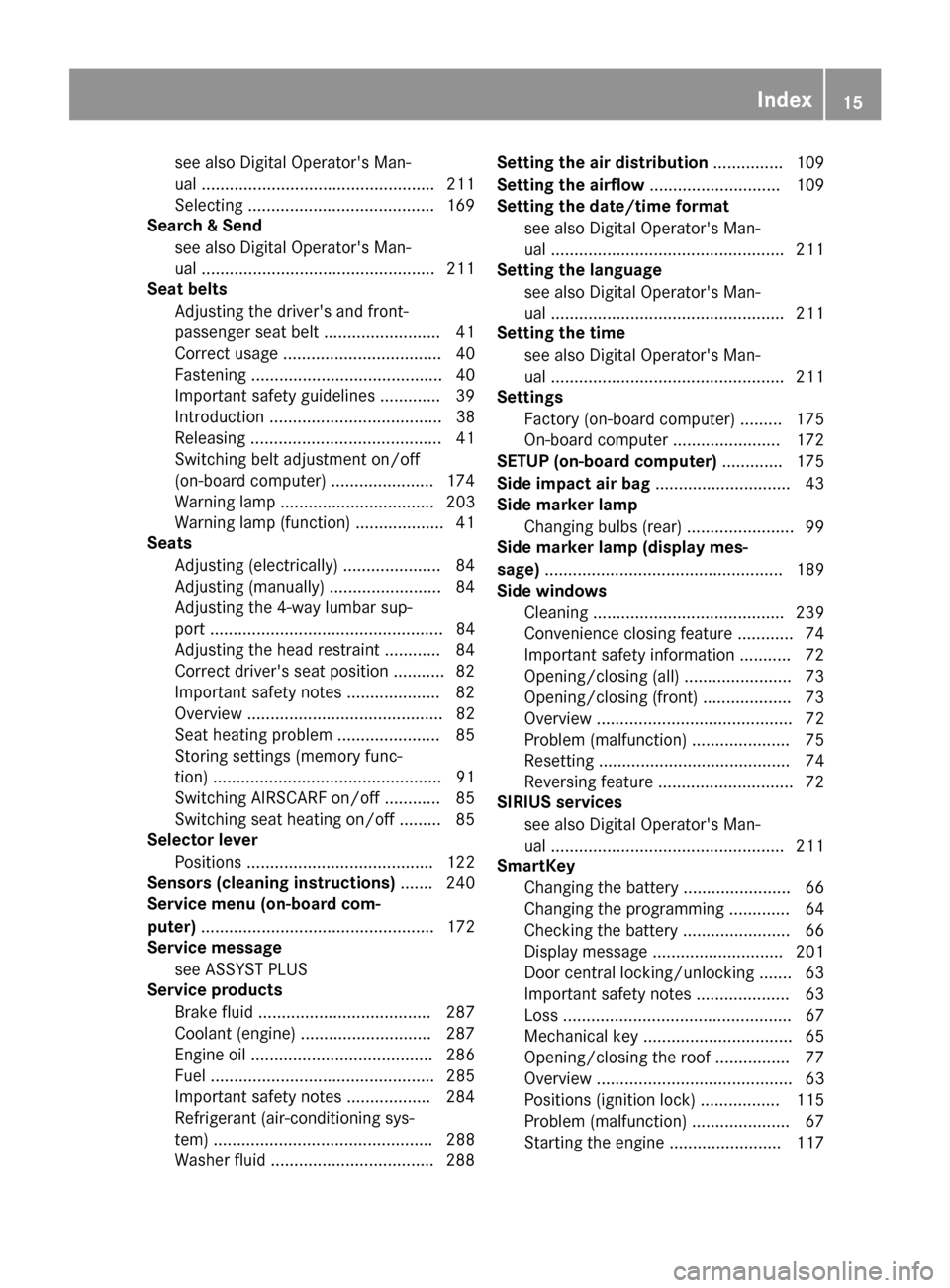
see also Digital Operator's Man-
ual .................................................. 211
Selecting ........................................169
Search&S end
see also Digita lOperator's Man-
ua l..................................................2 11
Seat belts
Adjusting the driver's and front-
passenger seatb elt......................... 41
Correct usag e.................................. 40
Fastening ......................................... 40
Important safety guideline s............. 39
Introduction ..................................... 38
Releasing ......................................... 41
Switching belt adjustment on/off
(on-board computer) ...................... 174
Warning lamp ................................. 203
Warning lamp (function) ................... 41
Seats
Adjusting (electrically) ..................... 84
Adjusting (manually) ........................ 84
Adjusting the 4-wa ylum bars up-
por t.................................................. 84
Adjusting the hea drestraint ............ 84
Correct driver' sseatp osition ........... 82
Important safety notes .................... 82
Overview .......................................... 82
Seath eating problem ...................... 85
Storing settings (memory func-
tion) ................................................. 91
Switching AIRSCAR Fon/of f............ 85
Switching sea theating on/of f......... 85
Selecto rlever
Positions ........................................ 122
Sensors (cleaning instructions) ....... 240
Servic emenu( on-board com-
puter) .................................................. 172
Servic emessage
see ASSYST PLUS
Servic eproducts
Brake fluid ..................................... 287
Coolant (engine) ............................ 287
Engine oil. ...................................... 286
Fue l................................................ 285
Important safety notes .................. 284
Refrigerant (air-conditioning sys-
tem) ............................................... 288
Washe rfluid ................................... 288 Setting the air distribution
............... 109
Setting the airflow ............................ 109
Setting the date/time format
see also Digital Operator's Man-
ual.................................................. 211
Setting the language
see al so Di
gital Operator's Man-
ua l.................................................. 211
Setting the time
see also Digital Operator's Man-
ual.................................................. 211
Settings
Factory (on-board computer) ......... 175
On-board compute r....................... 172
SETUP (on-board computer) ............. 175
Side impac tair bag ............................. 43
Side marker lamp
Changing bulb s(rear) ....................... 99
Side marker lamp (display mes-
sage) ................................................... 189
Side windows
Cleaning ......................................... 239
Convenience closing feature ............ 74
Important safety information ........... 72
Opening/closing (all )....................... 73
Opening/closing (front) ................... 73
Overview .......................................... 72
Problem (malfunction) ..................... 75
Resetting ......................................... 74
Reversing feature ............................. 72
SIRIU Sservices
see also Digital Operator's Man-
ua l.................................................. 211
SmartKey
Changing the battery ....................... 66
Changing the programming ............. 64
Checking the battery ....................... 66
Displa ymessage ............................ 201
Door centra lloc king/unlocking ....... 63
Important safety notes .................... 63
Loss. ................................................ 67
Mechanical key ................................ 65
Opening/closing the roo f................ 77
Overview .......................................... 63
Positions (ignition lock) ................. 115
Problem (malfunction) ..................... 67
Starting the engine ........................ 117
Index15
Page 24 of 294
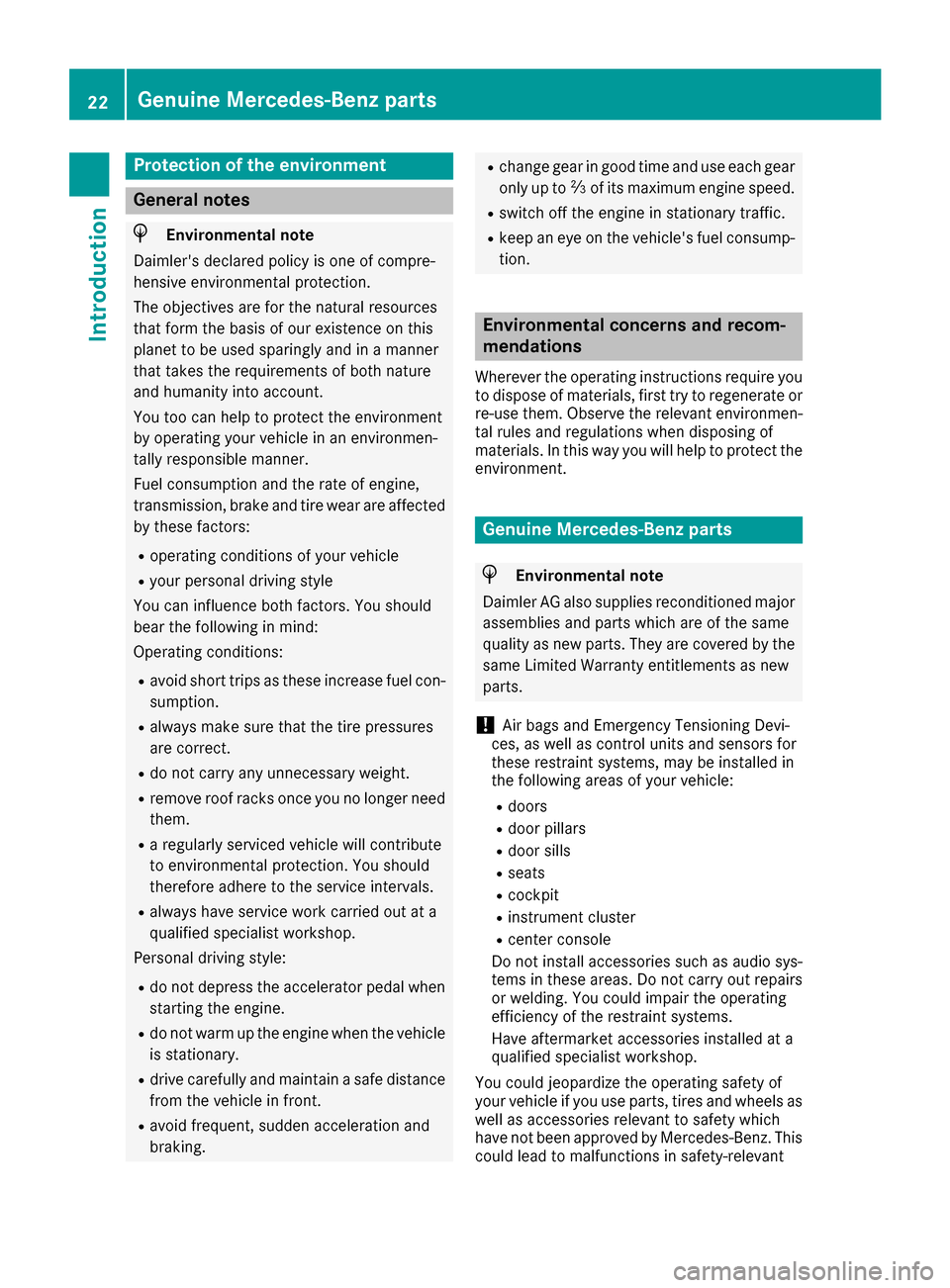
Protection of the environment
General notes
HEnvironmental note
Daimler's declared policy is one of compre-
hensive environmental protection.
The objectives are for the natural resources
that form the basis of our existence on this
planet to be used sparingly and in amanner
that takes the requirements of both nature
and humanity into account.
You too can help to protect the environment
by operating your vehicle in an environmen-
tally responsible manner.
Fuel consumption and the rate of engine,
transmission, brake and tire wear are affected by these factors:
Roperating conditionsofy our vehicle
Ryour personal driving style
You can influence both factors. You should
bear the following in mind:
Operating conditions:
Ravoid short trips as these increase fuel con-
sumption.
Ralways make sure that the tire pressures
are correct.
Rdo not carry any unnecessary weight.
Rremove roof racks once you no longer need
them.
Rar egularly serviced vehicle will contribute
to environmental protection. You should
therefore adhere to the service intervals.
Ralways have service work carried out at a
qualified specialist workshop.
Personal driving style:
Rdo not depress the accelerator pedal when
startin gthe engine.
Rdo not warm up the engine when the vehicle
is stationary.
Rdrive carefully and maintain asafe distance
from the vehicle in front.
Ravoid frequent, sudden acceleration and
braking.
Rchange gear in good time and use each gear
only up to Ôof its maximum engine speed.
Rswitch off the engine in stationary traffic.
Rkeep an eye on the vehicle's fuel consump-
tion.
Environmental concerns and recom-
mendations
Wherever the operating instructions require you
to dispose of materials, first try to regenerate or
re-use them. Observe the relevant environmen-
tal rules and regulations when disposing of
materials. In this way you will help to protect the
environment.
Genuine Mercedes-Benz parts
HEnvironmental note
Daimler AG also suppliesr econditioned major
assemblies and parts which are of the same
quality as new parts. They are covered by the
same Limited Warranty entitlements as new
parts.
!Air bags and Emergency Tensioning Devi-
ces, as well as control units and sensors for
these restraint systems, may be installed in
the following areas of your vehicle:
Rdoors
Rdoor pillars
Rdoor sills
Rseats
Rcockpit
Rinstrumentc luster
Rcenter console
Do not install accessories such as audio sys-
tems in these areas. Do not carry out repairs or welding. You could impair the operating
efficiency of the restraint systems.
Have aftermarket accessories installed at a
qualified specialist workshop.
You could jeopardize the operating safety of
your vehicle if you use parts, tires and wheels as
well as accessories relevant to safety which
have not been approved by Mercedes-Benz. This
could lead to malfunction sinsafety-relevant
22Genuine Mercedes-Benz parts
Introduction
Page 45 of 294
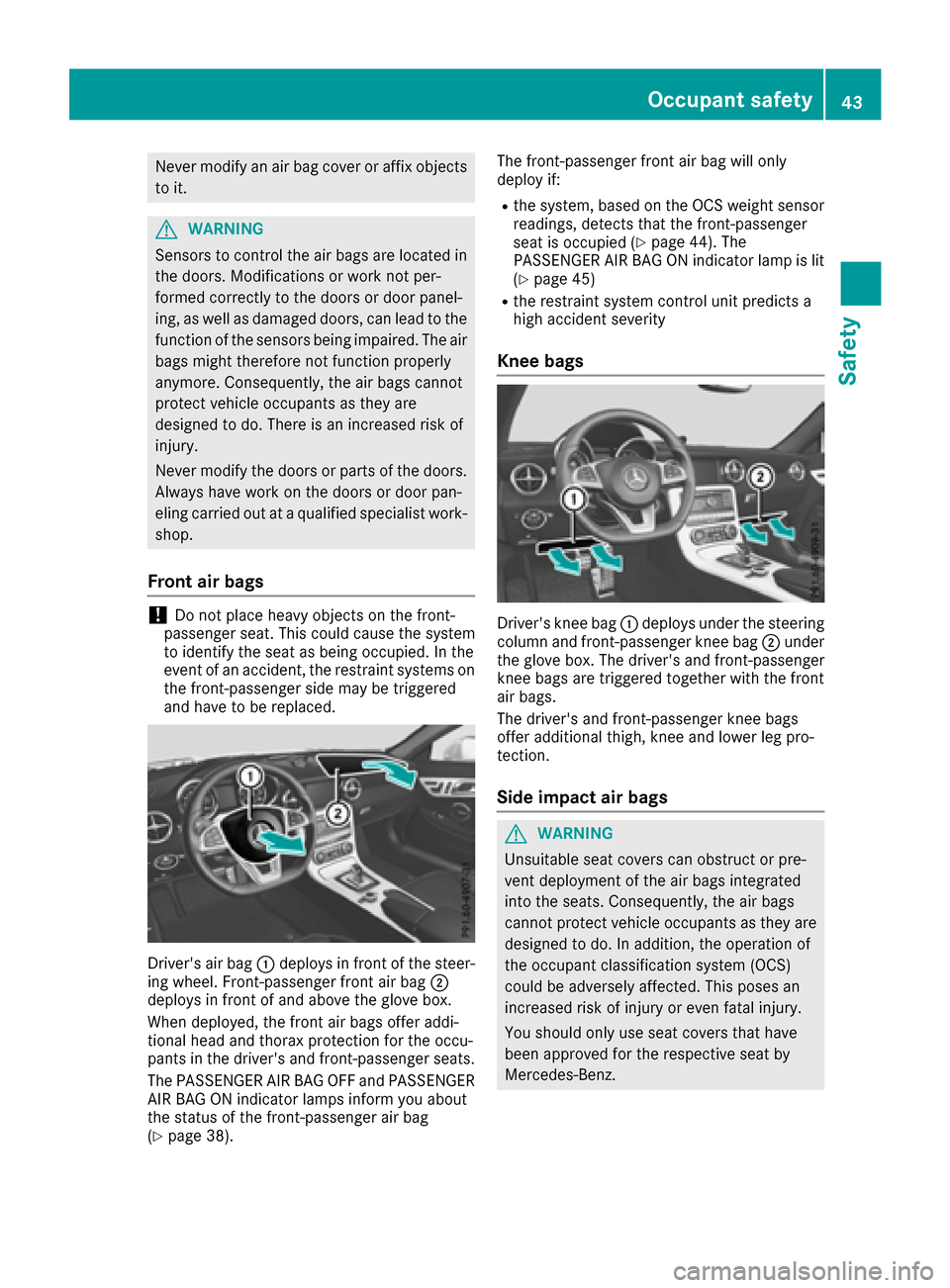
Never modify an air bag cover or affix objects
to it.
GWARNING
Sensors to control the air bags are located in
the doors. Modifications or work not per-
formed correctly to the doors or door panel-
ing, as well as damaged doors, can lead to the
function of the sensors being impaired. The air
bags might therefore not function properly
anymore. Consequently, the air bags cannot
protect vehicle occupants as they are
designed to do. There is an increased risk of
injury.
Never modify the doors or parts of the doors.
Alway shave work on the doors or door pan-
eling carried out at aqualifieds pecialist work-
shop.
Front air bags
!Do not place heavy objects on the front-
passenger seat. This could cause the system
to identify the seat as being occupied .Inthe
event of an accident, the restraint systems on
the front-passenger side may be triggered
and have to be replaced.
Driver's air bag :deploys in front of the steer-
ing wheel.F ront-passenger front air bag ;
deploys in front of and above the glove box.
When deployed, the front air bags offer addi-
tional head and thorax protection for the occu-
pants in the driver's and front-passenger seats.
The PASSENGER AIR BAG OFF and PASSENGER
AIR BAG ON indicator lamps inform you about
the status of the front-passenger air bag
(
Ypage 38). The front-passenger front air bag willo
nly
deployi f:
Rthe system, based on the OCS weight sensor
readings, detects that the front-passenger
seat is occupied (
Ypage 44). The
PASSENGER AIR BAG ON indicator lamp is lit
(
Ypage 45)
Rthe restraint system control unit predicts a
high accident severity
Kne ebags
Driver's knee bag :deploys under the steering
column and front-passenger knee bag ;under
the glove box. The driver's and front-passenger
knee bags are triggered together with the front
air bags.
The driver's and front-passenger knee bags
offer additional thigh, knee and lowerl eg pro-
tection.
Side impact air bags
GWARNING
Unsuitabl eseat covers can obstruct or pre-
vent deployment of the air bags integrated
into the seats. Consequently, the air bags
cannot protect vehicle occupants as they are designed to do. In addition, the operatio nof
the occupant classification system (OCS)
could be adversel yaffected. This poses an
increased risk of injury or even fatal injury.
You shoul donly use seat covers that have
been approve dfor the respective seat by
Mercedes-Benz.
Occupant safety43
Safety
Z
Page 58 of 294
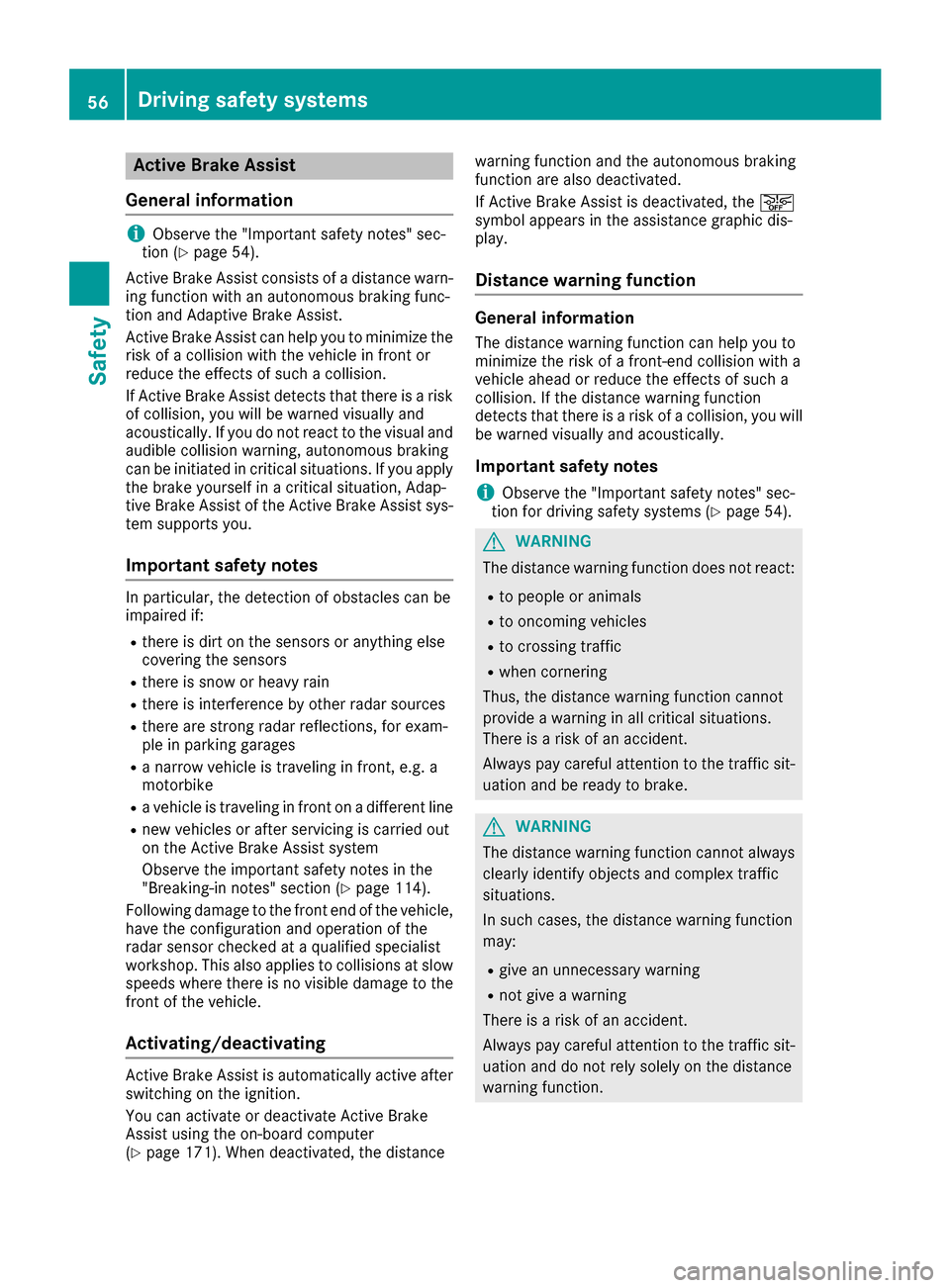
Active BrakeAssist
Gene ralinform ation
iObserv ethe "Importan tsafet ynotes "sec-
tion (Ypage 54).
Active Brake Assis tconsists ofad istanc ewarn-
ing function wit hanautonomous braking func-
tion and Adaptive Brake Assist.
Active Brake Assis tcan help you to minimiz ethe
ris kofac ollision wit hthe vehicl einfrontor
reduce th eeffects of suc hacollision .
If Active Brake Assis tdetects that there is arisk
of collision ,you will be warned visually and
acoustically. If you do no treac ttot hevisual and
audible collision warning ,autonomous braking
can be initiate dincritical situations. If you apply
th eb rak eyourself in acritical situation ,Adap-
tive Brake Assis toftheActive Brake Assis tsys-
te ms upport syou.
Import ant safety notes
In particular, th edetection of obstacles can be
impaire dif:
Rthere is dir tonthesensor soranythin gelse
covering th esensor s
Rthere is snow or heav yrain
Rthere is interferenc ebyother radar source s
Rthere are strongradar reflections, for exam-
ple in parking garages
Ran arrow vehicl eistraveling in front, e.g. a
motorbik e
Ravehicl eistraveling in fron tonadifferentlin e
Rne wv ehicles or after servicing is carrie dout
on th eActiv eBrake Assis tsystem
Observ ethe important safet ynotes in the
"Breaking-in notes" section (
Ypage 114).
Followin gdamag etothefron tend of th evehicle,
hav ethe configuration and operation of th e
radar sensor checke dataqualified specialis t
workshop .This also applie stocollision satslow
speeds wher ethere is no visible damag etothe
fron toft hevehicle.
Activating/deactivating
Active Brake Assis tisautomatically active after
switching on th eignition .
You can activat eordeactivat eActiv eBrake
Assis tusin gthe on-board computer
(
Ypage 171). When deactivated, th edistanc ewarning function and th
eautonomous braking
function are also deactivated.
If Active Brake Assis tisdeactivated, th eæ
symbol appear sintheassistanc egraphic dis-
play.
Distance warning function
Genera linformation
The distanc ewarning function can help you to
minimiz ethe riskofaf ront-end collision wit ha
vehicl eahead or reduce th eeffects of suc ha
collision .Ifthedistanc ewarning function
detects that there is ariskofac ollision ,you will
be warned visually and acoustically.
Important safety notes
iObserv ethe "Importan tsafet ynotes "sec-
tion for drivin gsafet ysystems (Ypage 54) .
GWARNIN G
The distanc ewarning function does no treact:
Rto people or animals
Rto oncomin gvehicles
Rto crossing traffic
Rwhen cornering
Thus ,the distanc ewarning function canno t
provid eawarning in all critical situations.
There is ariskofana ccident.
Always pay careful attention to th etraffic sit -
uation and be read ytob rake.
GWARNIN G
The distanc ewarning function canno talways
clearly identify objects and comple xtraffic
situations.
In suc hcases, th edistanc ewarning function
may:
Rgiv eanu nnecessary warning
Rnotg iveaw arning
There is ariskofana ccident.
Always pay careful attention to th etraffic sit -
uation and do no trelys olely on th edistanc e
warning function .
56Driving safety systems
Safety
Page 59 of 294
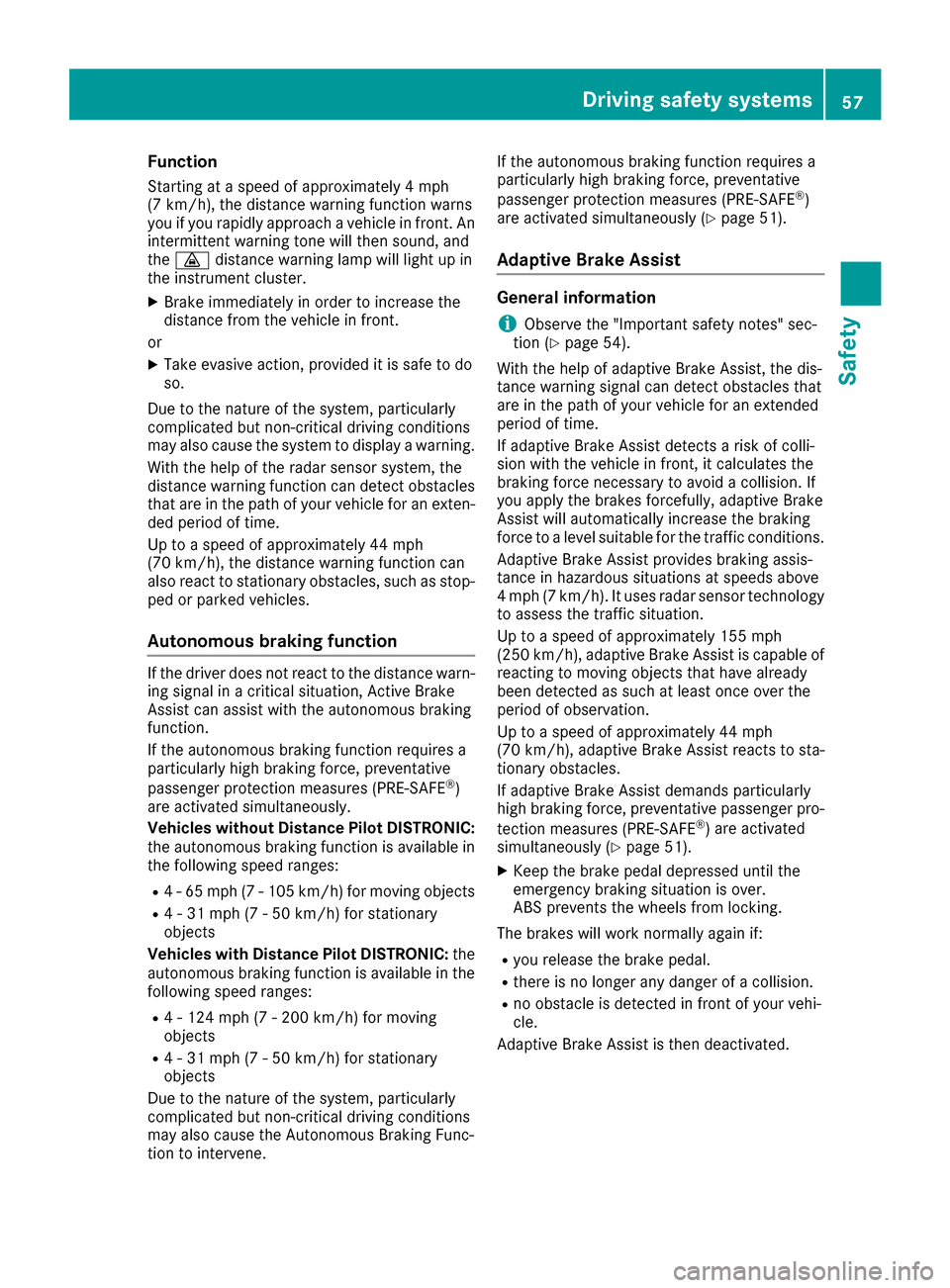
Function
Starting at aspeedofa pproximately 4mph
(7 km/h), th edistanc ewarning function warns
you ifyou rapid ly approachav ehicle in front. An
intermittentw arning tonewillthen sound, and
the · distancewarning lamp willlight up in
th ei nstrumen tcluster.
XBrake immediately inorder to increas ethe
dist ancefromt heveh icle in front.
or
XTakee vasive action,p rovide ditiss afe todo
so.
Due to th enature of th esystem, particularly
co mpli cated but non-critical driving conditions
may also caus ethe system to displayaw arning.
Witht hehelp of th eradar sensor system, the
dist ancewarning function can detect obstacles
that are inthep athofy our veh iclefor an exten-
ded period of time.
Up to aspeedofa pproximately 44 mph
(70 km/ h),t he distance warnin gfunction can
also react to stationary obstacles, such as stop-
ped or parked vehicles.
Autonomous braking function
If the driver does not react to the distance warn-
ing signal in acritical situation, Active Brake
Assis tcan assist with the autonomous braking
function.
If the autonomous brakin gfunction requires a
particularly high brakin gforce, preventative
passenger protection measures (PRE-SAFE
®)
are activated simultaneously.
Vehicles without Distance Pilot DISTRONIC:
the autonomous brakin gfunction is available in
the following speed ranges:
R4-65m ph (7-105 km/ h)for moving objects
R4-31m ph (7-50km/h)for stationary
objects
Vehicles with Distance Pilot DISTRONIC: the
autonomous braking function is available in the
following speedr anges:
R4-124 mph (7 -200 km/h )for moving
objects
R4-31m ph (7-50km/h)for stationary
objects
Due to the nature of the system ,particularly
complicated but non-critical driving conditions
may als ocaus ethe Autonomou sBraking Func-
tion to intervene. If the autonomous braking function requires a
particularly high braking force, preventative
passenger protection measures (PRE-SAFE
®)
are activated simultaneousl y(Ypage51).
Adaptive Brake Assist
General information
iObservet he "Important safety notes" sec-
tion (Ypag e54).
With the help of adaptive Brake Assist, the dis-
tance warning signa lcan detect obstacles that
are in the path of you rvehiclef or an extended
period of time.
If adaptive Brake Assist detects arisk of colli-
sion with the vehicl einfront, it calculate sthe
braking force necessary to avoi dacollision. If
you apply the brakes forcefully ,adaptive Brake
Assist wil lautomatically increas ethe braking
force to alevels uitabl efor the traffic conditions.
Adaptive Brake Assist provides braking assis-
tance in hazardouss ituations at speeds above
4m ph (7 km/h) .Itusesrada rsensor technology
to assess the traffic situation.
Up to aspeedofa pproximately 155 mph
(250 km/h) ,adaptive Brake Assist is capable of
reacting to moving objects that have already
been detected as such at least once over the
period of observation.
Up to aspeedofa pproximately 44 mph
(70 km/h), adaptive Brake Assist reacts to sta-
tionary obstacles.
If adaptive Brake Assist demands particularly
high braking force, preventative passenger pro-
tection measures (PRE-SAFE
®)a re activated
simultaneousl y(Ypage51).
XKeep the brake pedald epressed until the
emergency braking situation is over.
ABS prevents the wheels from locking.
The brakes wil lwork normally again if:
Ryou release the brake pedal.
Rthere is no longe rany dange rofacollision.
Rno obstacle is detected in front of you rvehi-
cle.
Adaptive Brake Assist is then deactivated.
Driving safety systems57
Safety
Z
Page 60 of 294
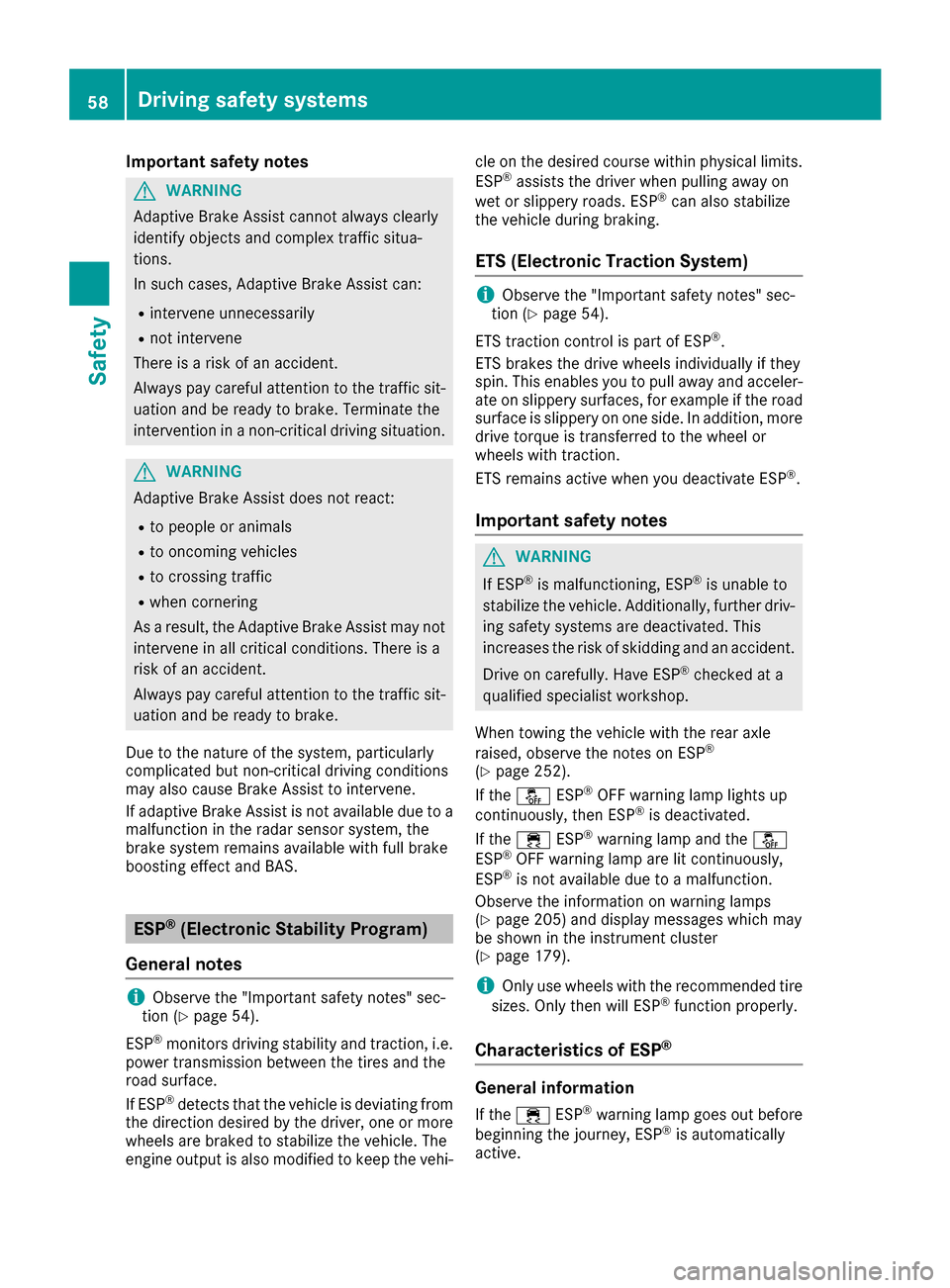
Important safety notes
GWARNING
Adaptive Brake Assist canno talways clearly
iden tifyo bject sand co mplextraffic situa-
tions.
In suchc ases, Adaptive Brake Assist can:
Rinterveneu nnecessarily
Rnotintervene
Thereisar iskofana cciden t.
Always pay careful attentio ntothetraff icsit-
uation and beread ytob rake. Terminate the
interventio ninanon-criticaldriving situation.
GWAR NING
Adaptive Brake Assist does no treact:
Rto people or animals
Rto oncomin gvehicle s
Rto crossing traff ic
Rwhen cornering
As aresult, th eAdaptive Brake Assist may not
interveneina llcritical conditions. Thereisa
ris kofana cciden t.
Always pay careful attentio ntothetraff icsit-
uation and beread ytob rake.
Due to th enature of th esystem, particularly
co mpli cated but non-critical driving conditions
may also caus eBrake Assist to intervene.
If adaptive Brake Assist isno tavailab ledue to a
malfunctio nintheradar sensor system, the
brak esystem remains availab le withfull brake
boostin geffect and BA S.
ESP®(Electronic Stability Program)
General notes
iObserv ethe "Im portan tsafety notes" sec-
tio n(Ypage 54).
ESP
®monitors driving stabilit yand traction,i .e.
power transmission between th etires and the
road surface.
If ESP
®detect stha tthe veh icle is deviating from
th ed irection desired bythed river, oneorm ore
wheelsa re braked to stabiliz ethe veh icle.The
engineo utputisalso mod ifiedtok eept he veh i- cle on th
edesired course within physical limits.
ESP
®assists th edriver when pullingaway on
wet or slippery roads. ESP®can also stabilize
th ev ehicle durin gbraking.
ETS (Electronic Traction System)
iObserv ethe "Importan tsafety notes" sec-
tio n(Ypage 54).
ET St raction control is part of ESP
®.
ET Sb rakes th edrivew heelsi ndivid ually if they
spin.T his enables you to pull away and acceler-
ate on slippery surfaces, for example if th eroad
surface is slippery on ones ide.Inaddition,m ore
drivet orque istransferred to th ewheel or
wheelsw itht raction.
ET Sr emains active when you deactivate ESP
®.
Important safety notes
GWARNING
If ESP
®is malfunctioning, ESP®is unab leto
stabilizet hevehicle .Add itionally, further driv-
ing safety systems are deactivate d.This
increases th eriskofs kiddin gand an accident.
Drive on carefully. Hav eESP
®checked at a
qualified specialist workshop.
When to wingthe vehicle witht herear axle
raised, observ ethe note sonE SP
®
(Ypage 252).
If the å ESP®OFFw arning lamp lightsu p
continuously, then ESP®is deactivate d.
If the ÷ ESP®warning lamp and the å
ESP®OFFw arning lamp are lit continuously,
ESP®is no ta vailab ledue to amalfunction.
Observ ethe information on warning lamps
(
Ypage 205) and display messagesw hichmay
be shown in thei nstrumen tcluster
(
Ypage 179).
iOnly use wheelsw itht he recommended tire
sizes. Only then willESP®function properly.
Characteristics of ESP®
General information
Ifthe ÷ ESP®warning lamp goes out before
beginnin gthe journey, ESP®is automatically
active.
58Driving safety systems
Safety
Page 66 of 294
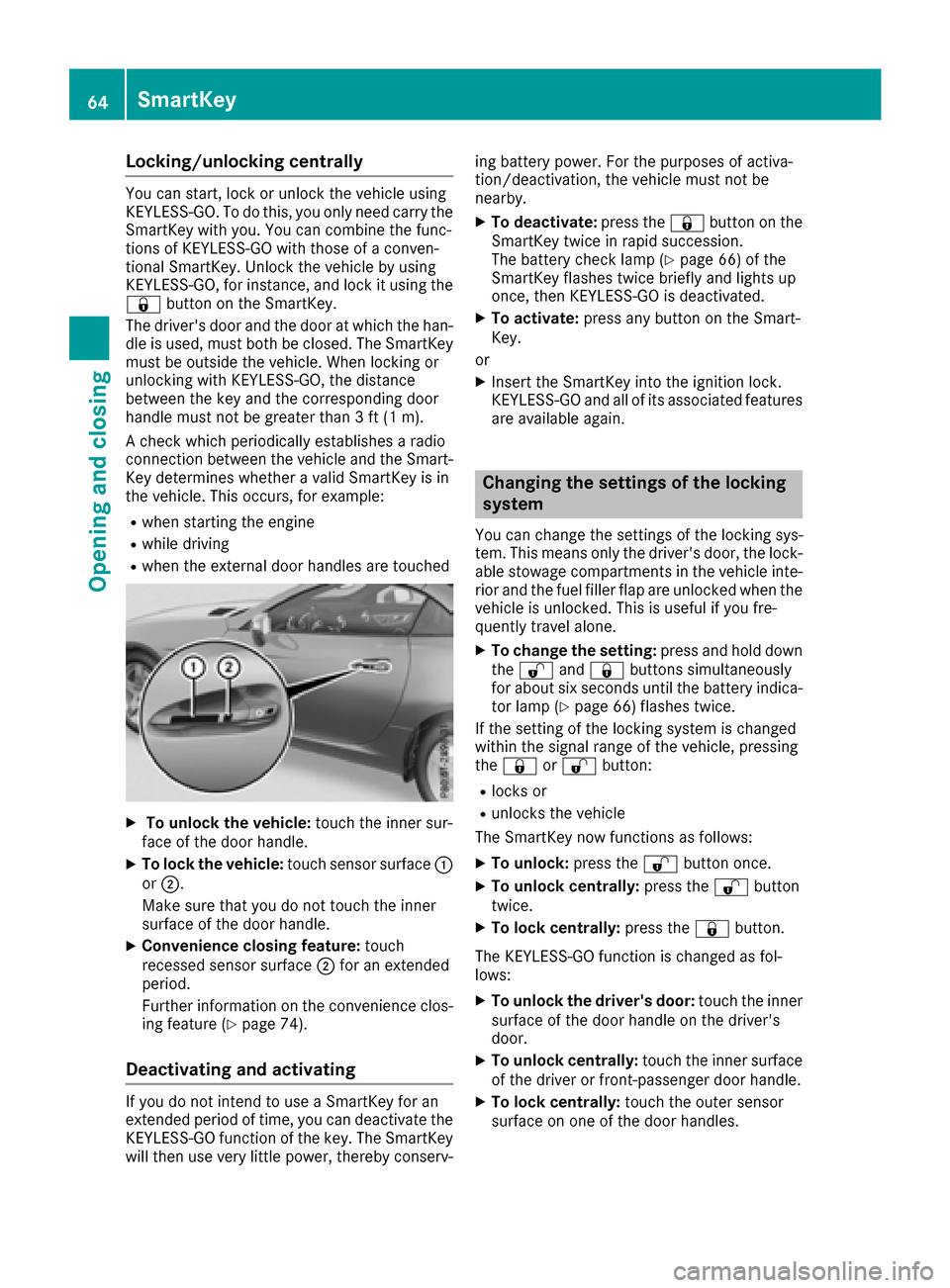
Locking/unlockingcentrally
You can start,lockorunlock thevehicle using
KEYLESS-GO .Todothis, you onl yneedc arry the
SmartKey with you. You can combine th efunc-
tions of KEYLESS-GO with those of aconven-
tional SmartKey. Unlockt hevehicle by using
KEYLESS-GO ,for instance, and lockitu singthe
& button on th eSmartKey.
The driver' sdoor and th edoor at whicht hehan-
dle is used, must bothbec losed. The SmartKey
must be outside th evehicle .When locking or
unlocking with KEYLESS-GO ,the distance
between th ekey and th ecorresponding door
handle must not be greater than 3ft(1m).
Ac heck whichp eriodicallyestablishesar adio
connectio nbetween th evehicle and th eSmart-
Key determine swhether avalid SmartKey is in
th ev ehicle .This occurs, for example:
Rwhen starting th eengine
Rwhile driving
Rwhen th eexternal door handles are touched
XTo unlock th evehicle: touch th einner sur-
fac eoft hedoor handle.
XTo lock th evehicle: touch sensor surface :
or ;.
Makes ure that you do not touch th einner
surface of th edoor handle.
XConvenience closing feature: touch
recesseds ensor surface ;for an extended
period.
Further informatio nontheconvenience clos-
ing feature (
Ypage 74).
Deactivating and activating
If you do not intend to use aSmartKey for an
extended perio doftime, you can deactivate the
KEYLESS-GO function of th ekey. The SmartKey
will then use veryl ittle power,therebyc onserv- ing battery power.F
or thepurposes of activa-
tion/deactivation, th evehicle must not be
nearby.
XTo deactivate: pressthe& button on the
SmartKey twic einrapid succession.
The battery check lamp (
Ypage 66 )ofthe
SmartKey flashes twic ebriefly and lightsu p
once, then KEYLESS-GO is deactivated.
XTo activate: pressany button on th eSmart-
Key.
or
XInsertt heSmartKey int othe ignitio nlock.
KEYLESS-GO and all of its associate dfeatures
are available again.
Changing th esettings of th elocking
system
You can change th esettings of th elockin gsys-
tem .This meanso nlyt he driver' sdoor,t helock-
able stowage compartments in th evehicle inte-
rior and th efuel filler flap are unlocked when the
vehicle is unlocked. This is useful if you fre-
quently travel alone.
XTo change th esetting: pressand hold down
the % and& buttons simultaneously
for about six second suntil th ebattery indica-
to rlamp (
Ypage 66 )flashes twice.
If th esettin goft helockin gsystem is changed
within th esignal range of th evehicle ,pressing
the & or% button:
Rlocks or
Runlock sthe vehicle
The SmartKey now functionsasf ollows:
XTo unlock:pressthe % button once.
XTo unlock centrally: pressthe % button
twice.
XTo lock centrally: pressthe& button.
The KEYLESS-GO function is changed as fol-
lows:
XTo unlock th edriver's door: touch theinner
surface of th edoor handle on th edriver's
door.
XTo unlock centrally: touch theinner surface
of th edriver or front-passenger door handle.
XTo lock centrally: touch theouter sensor
surface on one of th edoor handles.
64SmartKey
Opening and closing
Page 76 of 294
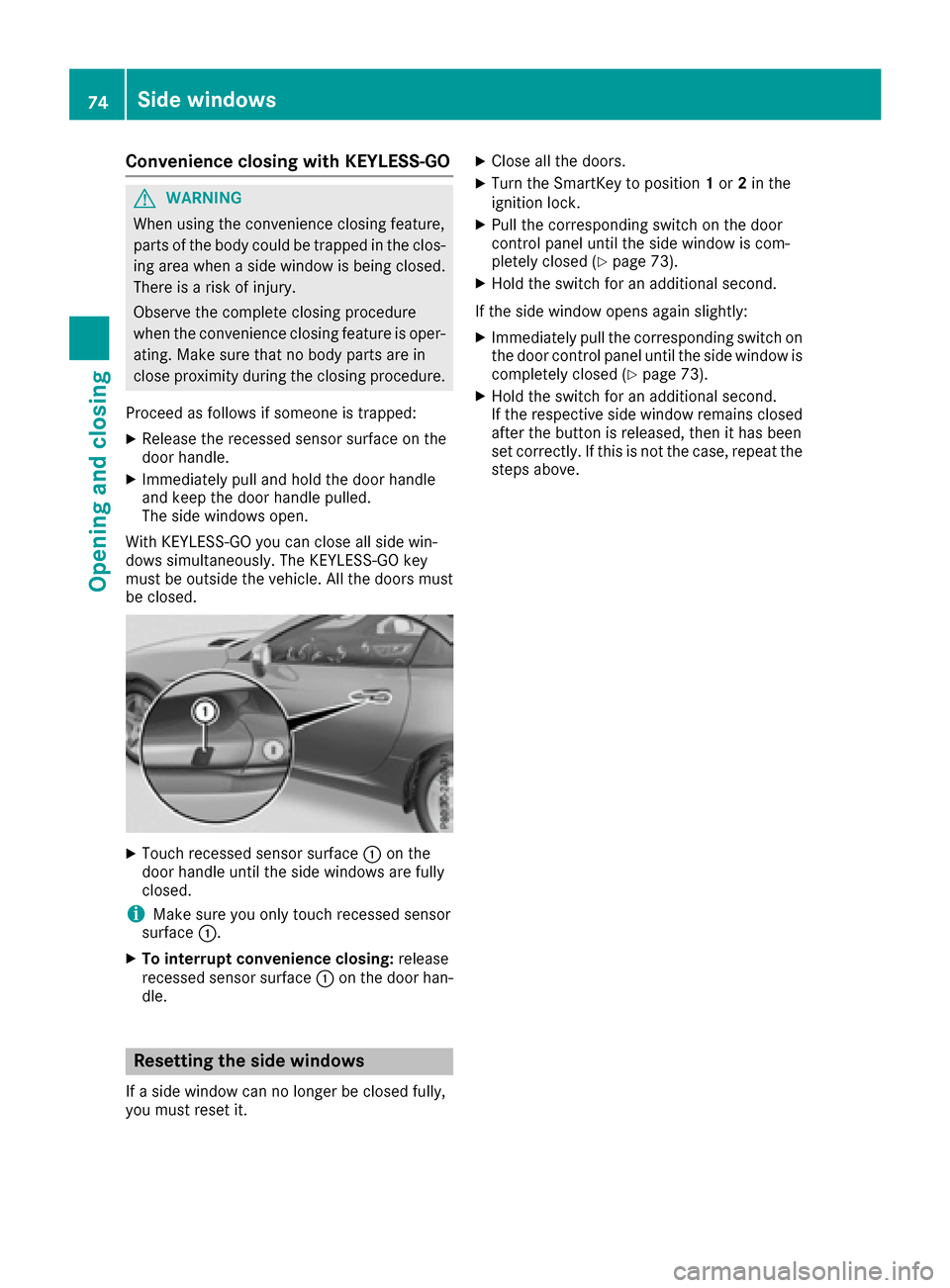
Convenience closing with KEYLESS-GO
GWARNING
When usingt heconvenience closingf eature,
part soft hebody coul dbetrapped in th eclos-
ing area when aside window is beingc losed.
Thereisar iskofi njury.
Observ ethe completec losingprocedure
when th econvenience closingf eature is oper-
ating. Makes ure that no body partsa re in
close proximity durin gthe closingp rocedure.
Procee dasfollows if someoneist rapped:
XRelease th erecessed sensor surface on the
door handle.
XImmediately pull and hold th edoor handle
and keep th edoor handle pulled.
The side windows open.
WithK EYLESS-GO you can close all side win-
dows simultaneously. The KEYLESS-GO key
must be outside th evehicle .All th edoorsm ust
be closed.
XTouchr ecessed sensor surface :on the
door handle until th eside windows are fully
closed.
iMakes ure you only touch recessed sensor
surface :.
XTo interrup tconvenience closing: release
recessed sensor surface :on th edoor han-
dle.
Resetting th esidew indows
Ifas ide window can no longer be closed fully,
you must reset it.
XClose all th edoors.
XTurn th eSmartKey to position 1or 2in the
ignition lock.
XPull th ecorrespondings witch on thedoor
control panel until th eside window is com-
pletely closed (
Ypage 73).
XHol dthe switch for an additional second.
If th eside window opensa gain slightly:
XImmediately pull thecorrespondings witch on
th ed oor control panel until th eside window is
completely closed (
Ypage 73).
XHol dthe switch for an additional second.
If th erespectiv eside window remains closed
after th ebutto nisr eleased, then it has been
set correctly. If this is no tthe case, repeat the
steps above.
74Sidew indows
Opening and closing